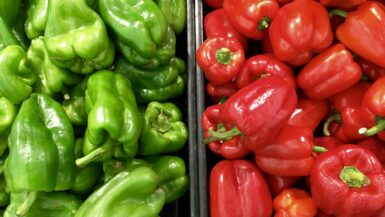In recent years, the importance of eating locally has become a popular topic of discussion among health enthusiasts and environmentalists alike. Eating locally means consuming food that is grown and produced within a certain radius of where you live. Not only does this practice support local farmers and businesses, but it also has numerous health benefits. In this article, we will explore the importance of eating locally for a healthy diet and how it can positively impact your overall well-being. From reducing your carbon footprint to consuming fresh, nutrient-dense foods, we will delve into the many reasons why eating locally is a smart choice for both your health and the planet.
What is local food and why is it important for a healthy diet?
Eating locally grown food means consuming food that is produced and harvested within a certain radius of your home, typically within 100 miles. The concept of eating locally has gained popularity in recent years due to the increasing awareness of the benefits of consuming fresh, seasonal food that is grown sustainably.
One of the primary benefits of eating locally is that it can provide you with a healthier diet. When you eat locally grown food, you have access to fresh, seasonal produce that is picked at the peak of ripeness, which means it is more nutrient-dense and flavorful than produce that is shipped from far away. Moreover, local food is often grown using sustainable farming practices that do not rely on synthetic pesticides and fertilizers, which can have harmful effects on your health.
In addition to being healthier, eating locally grown food can also help support your local economy and reduce your carbon footprint. By purchasing food from local farmers, you are supporting small businesses and keeping money within your community. Furthermore, buying locally grown food reduces the distance that your food has to travel to get to your plate, which means fewer greenhouse gas emissions from transportation.
Overall, eating locally grown food is an excellent way to support your health, your community, and the environment. In the following sections, we will explore the many benefits of eating locally in more detail and provide tips for incorporating local food into your diet.
The benefits of eating locally grown food for your health
Eating locally grown food has numerous benefits for your health. Here are some of the most important ones:
1. More Nutritious
Locally grown food is typically harvested at the peak of ripeness and consumed soon after, which means it is fresher and more nutrient-dense than food that has been transported over long distances. Nutrient losses can occur during transportation and storage, so when you eat locally, you get the most nutritional value out of your food.
2. Free of Harmful Chemicals
Many local farmers use sustainable farming practices that do not rely on synthetic pesticides and fertilizers. This means that the food you eat is less likely to contain harmful chemicals that can have negative effects on your health.
3. Supports a Diverse Diet
When you eat locally, you have access to a wider variety of fruits and vegetables, including heirloom varieties that are not commonly found in grocery stores. This can help you maintain a diverse and healthy diet.
4. Boosts Immune System
Eating locally grown food can also help boost your immune system. Local honey, for example, contains pollen from local flowers, which can help reduce allergy symptoms. Additionally, consuming a diverse range of local fruits and vegetables can provide your body with the vitamins and minerals it needs to fight off illness and disease.
5. Better Taste
When food is picked at the peak of ripeness and consumed soon after, it is more flavorful and delicious than food that has been transported long distances. Eating locally can help you rediscover the joy of eating fresh, delicious food.
Overall, eating locally grown food can have numerous benefits for your health. When you eat food that is fresh, nutritious, and free of harmful chemicals, you can feel good about the choices you are making for your health and the health of your community.
How eating locally can help reduce your carbon footprint
Eating locally grown food can have a positive impact on the environment by reducing your carbon footprint. Here are some ways that eating locally can help reduce your impact on the planet:
1. Reduces Transportation Emissions
When you buy food that has been transported over long distances, it requires more fuel and emits more greenhouse gases than food that is grown and consumed locally. By eating locally, you can significantly reduce the amount of emissions associated with your food.
2. Supports Sustainable Farming Practices
Many local farmers use sustainable farming practices that reduce the need for synthetic fertilizers and pesticides. These practices can help reduce the amount of greenhouse gases that are emitted during the production of food.
3. Preserves Farmland and Wildlife Habitat
When you support local farmers, you are helping to preserve farmland and wildlife habitat in your community. This can help reduce the amount of land that is converted for development, which can have a significant impact on the environment.
4. Reduces Food Waste
When food is transported over long distances, it is more likely to spoil or go to waste. By eating locally, you can reduce the amount of food waste that is generated, which can help reduce greenhouse gas emissions from landfills.
5. Encourages a Circular Economy
When you buy food from local farmers, you are supporting a circular economy in which resources are reused and recycled within a local community. This can help reduce waste and emissions associated with the production and transportation of goods.
Overall, eating locally grown food can have a significant impact on reducing your carbon footprint and supporting a more sustainable food system. By choosing to eat locally, you can make a positive impact on the environment and support the health of your community.
The economic benefits of supporting local farmers and businesses
Eating locally grown food can have positive economic impacts on your community. Here are some examples of how supporting local farmers and businesses can benefit your local economy:
1. Supports Small Businesses
When you buy food from local farmers, you are supporting small businesses in your community. This can help create jobs and stimulate economic growth, which can have a positive impact on your local economy.
2. Keeps Money in the Community
When you buy food from local farmers, your money stays within your community, which can help support other local businesses and services. This can help create a more resilient local economy that is less dependent on outside sources of income.
3. Reduces Dependence on Imports
When you eat locally grown food, you are helping to reduce your community’s dependence on imported food. This can help create a more self-sufficient local food system that is less vulnerable to disruptions in global supply chains.
4. Promotes Food Security
When you support local farmers, you are helping to promote food security in your community. This can help ensure that everyone has access to fresh, healthy food, regardless of their income or social status.
5. Preserves Farmland
When you buy food from local farmers, you are helping to support the preservation of farmland in your community. This can help protect open spaces and wildlife habitat, which can have positive environmental and economic impacts.
Overall, supporting local farmers and businesses can have many economic benefits for your community. By choosing to eat locally grown food, you can help create a more resilient and sustainable local economy that benefits everyone.
Tips for finding and incorporating local foods into your diet
If you are interested in eating locally grown food, here are some tips for finding and incorporating local foods into your diet:
1. Shop at Farmers Markets
Farmers markets are a great place to find locally grown food. You can meet local farmers, learn about their farming practices, and purchase fresh, seasonal produce. Many farmers markets also offer a variety of other local products, such as honey, cheese, and baked goods.
2. Join a CSA
Community-supported agriculture (CSA) programs allow you to purchase a share of a local farm’s harvest. You will receive a weekly or bi-weekly box of fresh, seasonal produce throughout the growing season. This is a great way to support local farmers and try new vegetables.
3. Visit Local Farms
Many local farms offer tours or events that allow you to see where your food comes from and learn about sustainable farming practices. This can be a fun and educational experience for the whole family.
4. Buy Directly from Farmers
Many local farmers sell their products directly to consumers through farm stands or online marketplaces. This is a great way to support local businesses and get fresh, seasonal produce.
5. Grow Your Own
If you have space in your yard or access to a community garden, consider growing your own fruits and vegetables. This is a fun and rewarding way to eat locally and reduce your carbon footprint.
6. Plan Your Meals Around Seasonal Produce
When you eat locally, it’s important to plan your meals around what’s in season. This can help you get the most flavorful and nutritious produce, and it can also help you save money.
By following these tips, you can easily find and incorporate locally grown food into your diet. Eating locally is a great way to support your health, your community, and the environment.
The environmental impact of eating locally grown food
Eating locally grown food can have a positive impact on the environment in several ways. Here are some examples:
1. Reduces Food Miles
Food miles refer to the distance that food travels from the farm to your plate. When you buy locally grown food, you are reducing the number of food miles associated with your food. This can help reduce greenhouse gas emissions from transportation, which can have a positive impact on the environment.
2. Supports Sustainable Farming Practices
Many local farmers use sustainable farming practices that reduce the use of synthetic fertilizers and pesticides. This can help reduce the amount of pollution that is released into the environment and promote the health of local ecosystems.
3. Preserves Biodiversity
When you eat locally grown food, you are supporting local ecosystems and promoting biodiversity. Many local farmers grow heirloom varieties of fruits and vegetables that are not commonly found in grocery stores. This can help preserve genetic diversity and promote the health of local ecosystems.
4. Reduces Packaging Waste
When food is transported over long distances, it often requires more packaging to keep it fresh. By eating locally grown food, you can reduce the amount of packaging waste that is generated, which can have a positive impact on the environment.
5. Promotes Soil Health
Many local farmers use sustainable farming practices that promote soil health, such as crop rotation and cover cropping. This can help reduce erosion, promote water retention, and improve the health of local soil ecosystems.
Overall, eating locally grown food can have many positive environmental impacts. By reducing food miles, supporting sustainable farming practices, and promoting biodiversity, you can help create a more sustainable food system that benefits everyone.
The role of community-supported agriculture (CSA) in promoting local food systems
Community-supported agriculture (CSA) is a system that connects local farmers directly with consumers. CSA allows consumers to purchase a share of a farm’s harvest, which typically includes a variety of fresh produce, fruits, and sometimes other products such as eggs or meat. This system provides a reliable income for farmers and ensures that consumers have access to fresh and locally grown food.
CSA has become an increasingly popular way for consumers to support local agriculture and promote sustainable food systems. By participating in a CSA, consumers can develop a closer relationship with the farmers who grow their food and learn more about how their food is produced. This can lead to a greater appreciation for the work that goes into producing food and a deeper understanding of the challenges facing small-scale farmers.
In addition to supporting local agriculture, CSA can also have a positive impact on the environment. By reducing the distance that food needs to travel to get from the farm to the consumer, CSA can help to reduce carbon emissions associated with transportation. CSA can also promote sustainable farming practices, such as crop rotation and the use of natural fertilizers, which can help to reduce the environmental impact of agriculture.
CSA can also provide economic benefits to local communities. By supporting local farmers, consumers are helping to keep money within their community and support small businesses. This can help to create jobs and stimulate economic growth in rural areas.
If you’re interested in participating in a CSA, there are a few things to keep in mind. First, it’s important to find a CSA that is a good fit for your needs and preferences. Some CSAs may offer a wider variety of produce than others, or may specialize in certain crops. It’s also important to consider the cost of the CSA share and whether it fits within your budget.
Overall, community-supported agriculture plays an important role in promoting local food systems and supporting sustainable agriculture. By participating in a CSA, consumers can support local farmers, reduce their carbon footprint, and enjoy fresh and locally grown food.
The challenges and barriers to eating locally and how to overcome them
While eating locally grown food can have many benefits, there are also some challenges and barriers that can make it difficult for some people to incorporate local foods into their diet. Here are some of the most common challenges and some tips for overcoming them:
Availability
One of the biggest challenges to eating locally is availability. Depending on where you live, it may be difficult to find local foods in your grocery store or farmers market. This is especially true if you live in an urban area or in a region with a short growing season.
To overcome this challenge, try to seek out local food sources in your area. This may include visiting farmers markets, joining a CSA, or even growing your own food. You can also look for local food co-ops or specialty stores that focus on local and organic foods.
Cost
Another challenge to eating locally is cost. Locally grown foods can sometimes be more expensive than conventionally grown foods, especially if they are grown using organic practices.
To overcome this challenge, try to budget for local foods as part of your overall food budget. Look for ways to save money, such as buying in bulk or purchasing foods that are in season. You can also try growing some of your own food to save money.
Convenience
Another challenge to eating locally is convenience. It can be difficult to find the time to visit farmers markets or prepare meals using fresh, local ingredients.
To overcome this challenge, try to plan ahead and make local foods a priority in your meal planning. Look for recipes that use local ingredients and try to prepare meals in advance to save time. You can also try freezing or canning local foods to make them more convenient to use.
Lack of knowledge
Finally, one of the biggest barriers to eating locally is a lack of knowledge. Many people may not know where to find local foods or how to prepare them.
To overcome this challenge, try to educate yourself about local food sources in your area. Talk to local farmers or visit farmers markets to learn more about the foods that are available. You can also look for local cooking classes or workshops to learn new recipes and cooking techniques.
Overall, while there may be some challenges to eating locally, there are also many benefits. By seeking out local foods and making them a priority in your diet, you can support local farmers, reduce your carbon footprint, and enjoy fresh and healthy foods.
The importance of preserving local food traditions and cultural heritage
Local food traditions and cultural heritage are an important part of our food system. These traditions are often passed down through generations and reflect the unique history and culture of a region. By preserving these traditions, we can help to maintain the diversity and richness of our food system.
One of the ways that local food traditions are preserved is through the use of heirloom varieties of fruits and vegetables. Heirloom varieties are open-pollinated and have been passed down through generations of farmers. These varieties often have unique flavors and characteristics that are specific to a region or culture.
Preserving local food traditions can also help to support small-scale farmers and local food systems. By promoting the use of local and heirloom varieties, we can help to create a market for these products and support the farmers who grow them.
In addition to supporting local farmers, preserving local food traditions can also have health benefits. Many traditional foods are made using whole, unprocessed ingredients and can be rich in nutrients. By incorporating these foods into our diets, we can promote healthy eating and support local agriculture at the same time.
Finally, preserving local food traditions can help to promote cultural diversity and understanding. By learning about the foods and traditions of different cultures, we can gain a greater appreciation for the diversity of our world and the people who inhabit it.
Overall, preserving local food traditions and cultural heritage is an important part of promoting a healthy and sustainable food system. By supporting local farmers and promoting the use of local and heirloom varieties, we can help to maintain the diversity and richness of our food system and promote cultural understanding and appreciation.





Leave a reply